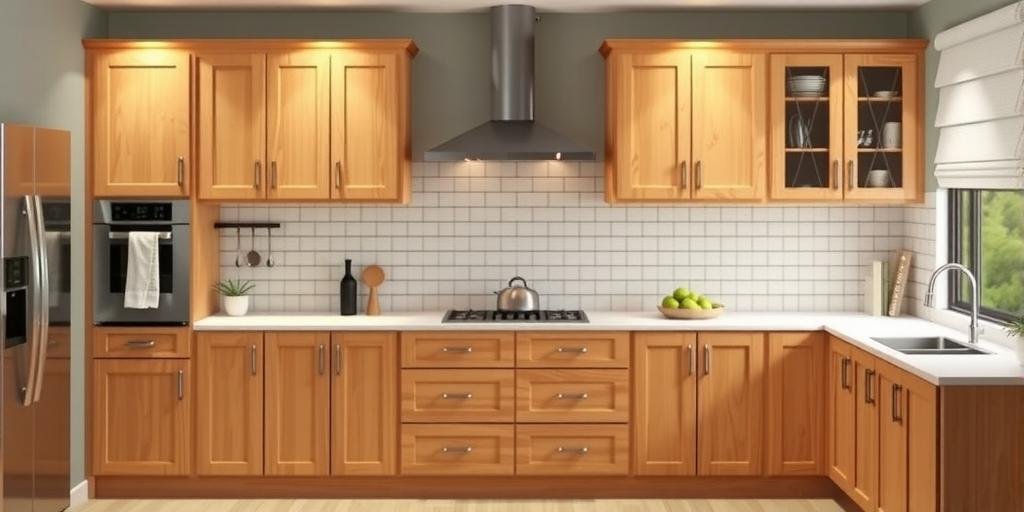When designing or remodeling a kitchen, understanding standard cabinet dimensions is crucial for functionality and aesthetics. One of the most common questions homeowners ask is: how deep are normal kitchen cabinets? The answer depends on the type of cabinet—base, wall, or pantry—and its intended use. Below, we break down standard kitchen cabinet depths and how they impact your kitchen layout.
Standard Kitchen Cabinet Depths
Kitchen cabinets come in three main types, each with standard depth measurements:
1. Base Cabinet Depth
Standard depth: 24 inches (61 cm)
Most base cabinets—the units that sit on the floor—are 24 inches deep. This depth accommodates:
- Countertop overhang (typically 1-1.5 inches)
- Standard appliances like microwaves and blenders
- Storage for pots, pans, and larger kitchen items
2. Wall Cabinet Depth
Standard depth: 12 inches (30.5 cm)
Wall cabinets are shallower than base cabinets to avoid obstructing workspace. A 12-inch depth allows for:
- Storing plates, glasses, and spices
- Easy reach without straining
- Clearance between the counter and cabinet for safe movement
3. Pantry Cabinet Depth
Standard depth: 24 inches (61 cm)
Tall pantry cabinets match base cabinet depth (24 inches) to store bulkier items like cereal boxes, canned goods, and small appliances.
Kitchen Cabinet Depth Variations
While standard depths are common, some cabinets deviate for specialized purposes:
| Cabinet Type | Depth Range | Common Uses |
|---|---|---|
| Base Corner Cabinets | 33-36 inches | Maximizing space in L-shaped kitchens |
| Pull-Out Pantry Cabinets | 15-18 inches | Narrow spaces, slim storage solutions |
| Appliance Garages | 20-24 inches | Hiding countertop appliances |
Why Cabinet Depth Matters
Choosing the right cabinet depth ensures:
- Workflow efficiency: Shallow wall cabinets prevent bumping your head, while deep base cabinets store bulky cookware.
- Appliance compatibility: Standard depths accommodate built-in microwaves, dishwashers, and refrigerators.
- Ergonomics: Proper depth reduces strain when reaching for items.
FAQ: Common Questions About Kitchen Cabinet Depth
1. Can kitchen cabinets be deeper than 24 inches?
Yes, but exceeding 24 inches in base cabinets may make accessing items at the back difficult. Custom depths are sometimes used for specialized storage.
2. Are European kitchen cabinets different?
European (metric) cabinets often use 60 cm (23.6 inches) for base units and 30-35 cm (12-14 inches) for wall units, slightly varying from U.S. standards.
3. How deep are upper cabinets above a fridge?
Upper cabinets near refrigerators typically match standard wall cabinet depth (12 inches) but may extend to 24 inches if recessed.
4. What’s the ideal depth for island cabinets?
Kitchen island cabinets often match base cabinet depth (24 inches), but deeper designs (up to 30 inches) are used for seating or extra storage.
Tips for Measuring Cabinet Depth
- Measure from the front face to the back wall of the cabinet.
- For framed cabinets, subtract 1-2 inches to account for the frame.
- Always verify appliance dimensions before finalizing cabinet depth.
Conclusion
Standard kitchen cabinet depths—24 inches for base cabinets and 12 inches for wall cabinets—ensure functionality and compatibility with appliances. While custom depths exist, sticking to these norms simplifies kitchen design and improves ergonomics. Always measure your space and consult a professional when planning a kitchen layout.

